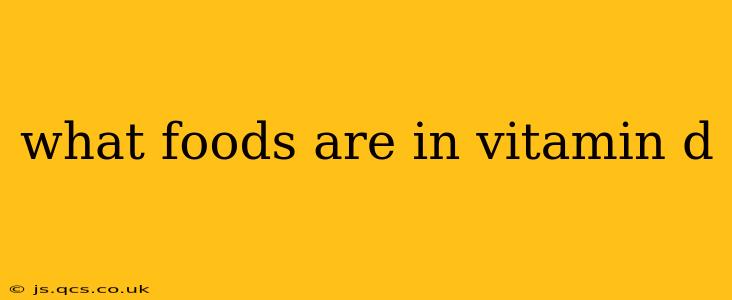Vitamin D is a fat-soluble nutrient crucial for bone health, immune function, and overall well-being. While sunlight exposure is a primary source, incorporating vitamin D-rich foods into your diet is essential, especially during winter months or for individuals with limited sun exposure. However, it's important to understand that many foods naturally contain only small amounts of vitamin D. Fortification is key to getting significant amounts from dietary sources.
What Foods Naturally Contain Vitamin D?
Naturally occurring vitamin D in food is relatively rare. The best natural sources are fatty fish.
-
Fatty Fish: Salmon, tuna, mackerel, and sardines are excellent sources of vitamin D. A 3-ounce serving of these fish can provide a significant portion of your daily recommended intake. However, the amount varies depending on the type of fish and its environment.
-
Egg Yolks: Egg yolks contain a small amount of vitamin D, but the quantity varies greatly depending on the hen's diet and the farming practices.
-
Mushrooms: Certain types of mushrooms, particularly those exposed to ultraviolet (UV) light during growth, produce vitamin D2. However, the amount varies significantly depending on the growing conditions.
It's crucial to remember that the vitamin D content in these natural sources is often relatively low compared to fortified foods.
What Foods Are Fortified with Vitamin D?
Many foods are fortified with vitamin D to boost their nutritional value. These are often more reliable sources of this essential vitamin.
-
Milk and Milk Alternatives: Cow's milk, almond milk, soy milk, and oat milk are commonly fortified with vitamin D. Check the nutrition label to confirm the vitamin D content.
-
Cereals: Many breakfast cereals are fortified with vitamin D, along with other essential vitamins and minerals. Again, always check the nutrition label.
-
Orange Juice: Some brands of orange juice are fortified with vitamin D. Read the label carefully to identify fortified products.
-
Yogurt: Similar to milk, many yogurt products are fortified with vitamin D, offering a convenient way to increase your intake.
How Much Vitamin D Do I Need?
The recommended daily allowance of vitamin D varies depending on age and other factors. It's best to consult your doctor or a registered dietitian to determine your individual needs. They can consider your lifestyle, health conditions, and sun exposure to provide personalized recommendations.
Are There Any Risks Associated with Vitamin D from Food?
While vitamin D is essential, excessive intake can lead to hypervitaminosis D, characterized by high blood calcium levels. This can cause symptoms such as nausea, vomiting, weakness, and kidney stones. It's crucial to follow recommended daily allowances and not exceed them through diet alone. Over-consumption of fortified foods is a more likely cause of toxicity than from natural sources.
Can I Get Enough Vitamin D From Food Alone?
For many people, it's difficult to obtain sufficient vitamin D solely from dietary sources, even with careful food choices. Sunlight exposure remains a primary source of vitamin D for most individuals. Your doctor may recommend a vitamin D supplement to ensure you meet your daily needs, especially if you have limited sun exposure, darker skin, or certain health conditions.
What are the best sources of Vitamin D2 vs Vitamin D3?
Vitamin D2 (ergocalciferol) and Vitamin D3 (cholecalciferol) are the two main forms of vitamin D. Vitamin D3 is generally considered more effective at raising blood levels of vitamin D. Fatty fish tend to be better sources of Vitamin D3, while fortified foods can contain either D2 or D3. Always check the label to see which form is present.
What are some tips for increasing my Vitamin D intake?
- Prioritize fatty fish: Include salmon, tuna, or mackerel in your diet at least once or twice a week.
- Choose fortified foods: Opt for milk, yogurt, cereals, and orange juice fortified with vitamin D.
- Consider a supplement: Discuss with your doctor whether a vitamin D supplement is appropriate for you.
- Get some sunshine: Safe and sensible sun exposure can contribute to your Vitamin D levels. Remember to protect your skin from sunburn.
This comprehensive guide provides a clear understanding of vitamin D sources, emphasizing the need for a balanced approach combining diet, sunlight exposure, and potentially supplements, tailored to individual needs. Always consult a healthcare professional for personalized advice.
